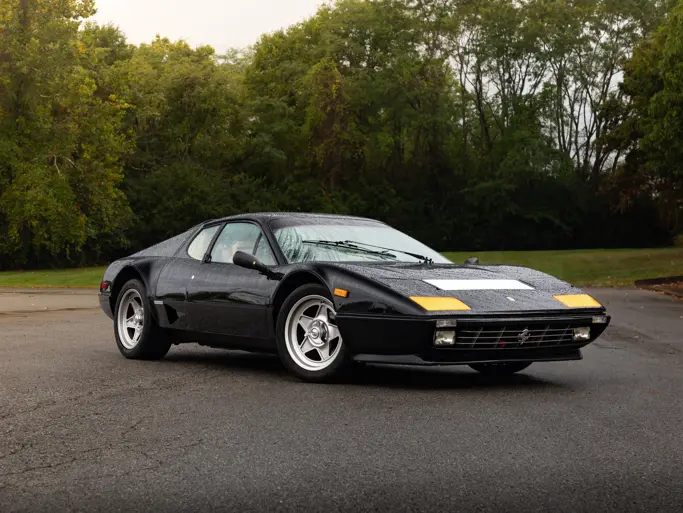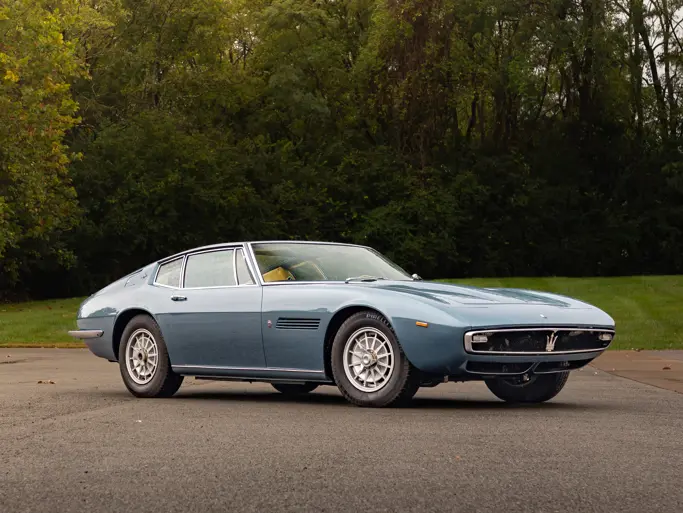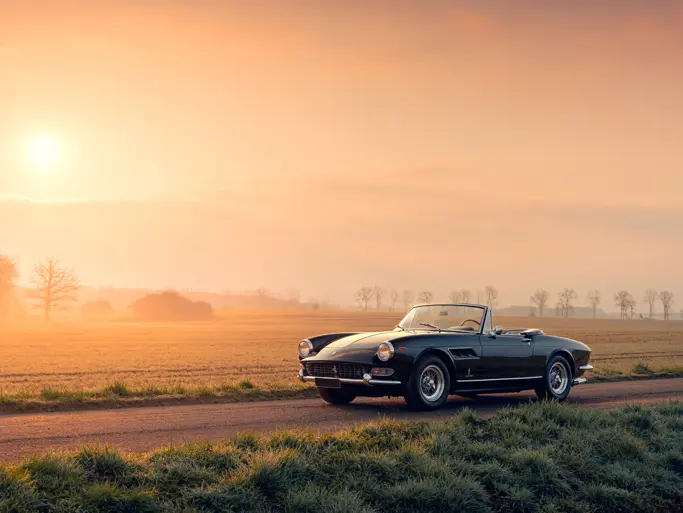240 bhp, 2,953 cc overhead camshaft alloy block and head V-12 engine, four-speed manual gearbox, independent front suspension via A-arms, coil springs and telescopic shocks, and rear suspension via live axle, semi-elliptic springs and hydraulic shocks, four-wheel hydraulic disc brakes. Wheelbase: 2,600 mm (102.4")
- Ex-Prince Alvise Hercolani and Wolfgang Seidel
- Special features including hardtop and Superamerica side vents
- Matching numbers and Ferrari Classiche certified
- Extensive recent detailing work and motor and suspension rebuild
- Shown at Pebble Beach Concours d’Elegance
- Known provenance, documented by Ferrari historian Marcel Massini
In the pantheon of desirable open Ferraris, the 250 GT California Spyder, in both long- and short-wheelbase form, stands head and shoulders above the rest. It has all the elements Ferraristi look for: the perpetually desirable Colombo V-12, considerable rarity and a successful competition pedigree to match its sporting Pinin Farina lines.
The California Spyder, in contrast to the luxurious custom-built 250 cabriolets that preceded it, was intended for the client in search of a fast, sparsely-equipped cabriolet Ferrari sports car, an open counterpart to the Tour de France berlinetta, perfect not only for spirited driving along the Pacific Coast or Cote d’Azur but also all-out racing.
California Spyder production began in 1958, and some 11 examples had been built by the time it was announced as a separate model in December 1958. One California Spyder was entered by N.A.R.T. at Sebring early in 1959 and driven by Richie Ginther and Howard Hively. It finished ninth overall (behind four Testa Rossas and four Porsche RSKs) and won the GT class. Le Mans in 1959 conclusively demonstrated the performance of the California Spyder as the N.A.R.T.-entered, alloy-bodied car driven by Bob Grossman and Fernand Tavano finished fifth overall.
Chassis no. 1307 GT
The spectacular Ferrari offered here is the twenty-third of the total 50 long-wheelbase California Spyders built and is unique among them for several desirable and distinctive features, including the unusual Superamerica-style front fender vents and an insert air intake on the hood. Delivered on 27 March, 1959 to Prince Alvise Hercolani of Bologna, its certificate of origin was issued by Ferrari on 3 April, 1959.
Hercolani retained 1307 GT for about six months, selling it to the racing driver and car dealer Wolfgang Seidel in October 1959. In fact, Seidel drove the car to the V Grand Prix de Bruxelles in Belgium, as pictured in Jean-Paul Delsaux’s book Les Grand Prix de Bruxelles. Seidel in turn sold the car in 1961 to the car’s third owner, Rolf Helm of Germany, before it was acquired by the fourth owner, William Morgan of Phoenix, Arizona. Morgan, who at the time lived in Wiesbaden, drove 1307 GT to Marseille, then put it on a boat to Corsica where he spent a two-week vacation with his wife. From there, the car boarded a boat for Genova before Morgan drove it to Modena.
Mr. Morgan would own the car for several more years. It was serviced at the factory in September 1963 and shipped to Pleasant Hills, California in 1965, as Morgan had since relocated back to the United States. 1307 GT was finally sold on 22 September, 1966 to Mr. Edwin K. Niles, an attorney from California.
The car then passed through two other known owners before it was acquired by the 29-year-old Jim Swartout, who would own the car for the next 30 years. In 1999, next owner Jonas Liden of Sweden commissioned a full restoration at Carrozzeria Autosport, Bacchelli & Villa in Bastiglia, Italy. Following a showing at the Ferrari Owners Club UK National Concours in 2001, the current owner acquired the car in 2003.
Recent history
After participating in the Texas 1000 and New England 1000, the car was stripped down to bare metal and refinished in a very attractive deep blue, the way it was during Seidel’s ownership. In fact, the owner believes the attractive silver hardtop was modified and adapted to this car during Wolfgang Seidel’s ownership. In addition to being shown at Meadow Brook in 2005, the car was also displayed at the 58th Annual Pebble Beach Concours d’Elegance in the special California Spyder category. As presented, it retains its original, matching-numbers type 128 D engine.
Most recently, the owner invested an additional $115,000 to bring the car to the Platinum Award-level standards mandated by the Ferrari Club of America. To that end, a complete motor and suspension rebuild were carried out by noted marque specialist Greg Jones. The convertible top and bows were restored, and the entire car was detailed appropriately to Platinum standards. As such, everything from restoring the instruments to fitting the correct inside mirror and replacing the exhaust tips was necessary. Furthermore, the side vents, which at some point were replaced by California Spyder side vents, were replaced with the correct 410 Superamerica pieces.
This exhaustive work has been documented with bills, receipts and photographs and, most importantly, was rewarded with certification by Ferrari Classiche, confirming the car is presented precisely the way it left the factory.
1307 GT is unique in several important respects. Most apparent is the switch box placed over the driveshaft tunnel just behind the shift lever. It contains the ignition switch and other controls which normally would be mounted on and below the dashboard and instrument panel, giving taller drivers more leg and knee room. As mentioned, 1307 GT also has distinctive Superamerica-style front fender vents formed from bright-finished aluminium. Fitted from new with the desirable and more reliable twin Marelli distributors, its three Weber carburettors breathe through factory-fitted velocity stacks and are contained within a cold air box, both highly desirable performance options fitted to only a few California Spyders.
As a long-wheelbase example, the trim, low lines of its topless coachwork are elegantly balanced by the placement of its wheels and tyres. The overall effect is long, low, sleek and decidedly sporting. The California Spyder is as close as Ferrari came to building a sports car since the early Barchettas, and only it and the later 275 GTB/4 N.A.R.T. Spyders have the elemental high-speed, open-air attitude that sets these cars apart from their more common cabriolet counterparts. 1307 GT is distinctive among even these rare and highly prized automobiles, the ideal mount for a variety of tours and events, or even, in the tradition of the late Bob Grossman, a competitive entry in the many historic racing and Ferrari club events where its participation would be welcomed.
240 cv, motore V-12 di 2.953 cc a camme in testa con monoblocco e teste in alluminio, cambio manuale a quattro marce, sospensione anteriore a ruote indipendenti con molle e ammortizzatori telescopici, sospensione posteriore con assale rigido, balestre semi-ellittiche e ammortizzatori idraulici, freni a disco idraulici sulle quattro ruote. Passo: 2.600 mm (102.4")
- In passato di proprietà del Principe Alvise Hercolani e di Wolfgang Seidel
- Allestimenti speciali fra i quali il tettuccio rigido e gli sfoghi d'aria laterali tipo Superamerica
- Stesso numero di telaio e motore; certificata da Ferrari Classiche
- Numerosi recenti lavori di dettaglio e revisione del motore e delle sospensioni
- Esibita al Concorso d'Eleganza di Pebble Beach
- Provenienza conosciuta, documentata dallo storico delle Ferrari Marcel Massini
Nel pantheon delle Ferrari aperte desiderabili, la 250 GT California Spyder, sia nella versione a passo lungo che in quella a passo corto, domina sulle altre. Ha tutti gli elementi che i Ferraristi cercano: rarità, il motore V-12 progettato da Colombo, eternamente allettante e un pedigree nelle competizioni che si unisce alle linee sportive di Pinin Farina.
La California Spyder, in contrasto con le precedenti lussuose 250 cabriolet costruite su richiesta, fu pensata per il cliente alla ricerca di una veloce Ferrari sportiva aperta, spartanamente equipaggiata, l'equivalente di una berlinetta Tour de France, perfetta non solo per la guida vivace sulle coste del Pacifico o della Costa Azzurra ma anche per gareggiare al massimo livello.
La produzione della California Spyder cominciò nel 1958 e ne erano stati prodotti già 11 esemplari quando fu presentata come modello a sé nel dicembre 1958. All'iniziò del 1959 una California Spyder, iscritta dalla N.A.R.T. a Sebring per i piloti Richie Ginther e Howard Hively, si classificò nona assoluta (dietro quattro Testa Rossa e quattro Porsche RSK) e prima della Classe GT. Alla 24 Ore di Le Mans nel 1959 la California Spyder mostrò in pieno le sue potenzialità, quando la vettura, iscritta dalla N.A.R.T. e guidata da Bob Grossman e Fernand Tavano, si classificò al quinto posto assoluto.
Il telaio n. 1307 GT
La spettacolare Ferrari offerta é la 23° delle 50 California Spyder a passo lungo costruite ed è unica, per i diversi particolari desiderabili e caratteristici, come gli inusuali sfoghi d'aria tipo Superamerica sulla fiancata anteriore e per la presa d'aria leggermente incavata sul cofano. Fu consegnata il 27 marzo 1959 al Principe Alvise Hercolani di Bologna e il suo certificato di origine fu emesso dalla Ferrari il 3 aprile 1959.
Il Principe Hercolani tenne la 1307 GT per circa sei mesi, vendendola poi nell'ottobre 1959 al pilota tedesco e commerciante di automobili Wolfgang Seidel. Seidel pilotò la vettura al V Grand Prix di Bruxelles in Belgio, come illustrato nel libro Les Grand Prix de Bruxelles di Jean-Paul Delsaux. Seidel vendette a sua volta la vettura nel 1961 al terzo proprietario, il tedesco Rolf Helm, dal quale la acquistò il quarto proprietario, William Morgan di Phoenix, in Arizona. Morgan, che all'epoca viveva a Wiesbaden, guidò la 1307 GT fino a Marsiglia e la fece caricare su un traghetto per la Corsica, dove passò una vacanza di due settimane con la moglie. Da lì, la vettura fu imbarcata per Genova e quindi Morgan la guidò fino a Modena.
Morgan avrebbe tenuto la vettura per diversi anni. Nel settembre 1963 passò in fabbrica per una manutenzione e nel 1965 fu inviata via mare a Pleasant Hills, in California, dove Morgan si era stabilito al ritorno negli Stati Uniti. La 1307 GT fu infine venduta il 22 settembre 1966 a Edwin K. Niles, un avvocato californiano.
La vettura ebbe poi altri due proprietari conosciuti prima di essere acquistata dal ventinovenne Jim Swartout, che l'avrebbe tenuta per i successivi 30 anni. Nel 1999, il successivo proprietario, lo svedese Jonas Liden, commissionò un restauro completo alla Carrozzeria Autosport di Bacchelli & Villa, a Bastiglia (Modena). Nel 2001 la vettura fu esibita al Concorso Nazionale del Ferrari Owners Club di Gran Bretagna e nel 2003 venne acquistata dall'attuale proprietario.
Storia recente
Dopo aver partecipato alla Texas 1000 e alla New England 1000, la vettura fu sverniciata, portata a lamiera nuda e riverniciata in un piacevolissimo blu scuro, la livrea che aveva quando era di proprietà di Seidel. In effetti, il proprietario ritiene che l'attraente hardtop grigio-argento sia stato modificato e adattato a questa vettura durante la proprietà di Seidel. Oltre ad essere stata esibita al concorso di Meadow Brook del 2005, la vettura è stata anche esposta alla 58° edizione del Concorso d'Eleganza di Pebble Beach, nella classe speciale California Spyder. Essa è offerta con ancora il suo motore d'origine tipo 128 D, con lo stesso numero del telaio.
Più di recente, il proprietario ha investito altri 115.000 dollari per portare la vettura agli standard della Targa Platino, come definiti dal Ferrari Club of America. A tal fine, il motore e le sospensioni sono stati completamente revisionati dal noto specialista della marca Greg Jones. Il telaietto della capote e la relativa tela sono stati restaurati, e l'intera vettura è stata curata nei dettagli per essere conforme ai criteri della Targa Platino. E' stato quindi necessario restaurare gli strumenti, montare un corretto specchietto retrovisore interno e sostituire i terminali di scarico. Inoltre, gli sfoghi d'aria laterali, che in un certo momento erano stati sostituiti con quelli della California Spyder, sono stati nuovamente sostituiti con pezzi corretti della 410 Superamerica.
Questo esauriente lavoro è ben documentato con fatture, ricevute e fotografie e, cosa più importante, è stato premiato con la certificazione di Ferrari Classiche, che conferma che la vettura si presenta esattamente uguale a come aveva lasciato la fabbrica da nuova.
La 1307 GT è unica per diverse e importanti caratteristiche. Il più evidente è la nicchia per i comandi sistemata sul tunnel della trasmissione subito dietro la leva del cambio. Essa contiene il blocchetto d'accensione e le altre leve che normalmente sono montate sopra e sotto il cruscotto e questa soluzione lascia maggiore spazio alle gambe e alle ginocchia dei guidatori più alti. Come già detto, la 1307 GT ha anche specifiche uscite d'aria sui parafanghi anteriori, in stile Superamerica e in alluminio lucidato. E' dotata fin da nuova con due affidabili e più richiesti spinterogeni Marelli, con tre carburatori Weber con i tromboncini d'aspirazione alimentati tramite un convogliatore d'aria a forma di vasca, opzioni entrambe molto desiderate e montate solo su poche California Spyder.
E' un esemplare su telaio a passo lungo e le pulite, basse linee della sua carrozzeria aperta sono elegantemente bilanciate dal posizionamento di cerchi e pneumatici. In assoluto l'immagine è quella di una vettura lunga, bassa, slanciata e decisamente sportiva. La California Spyder è quanto di più vicino ci possa essere alle prime Barchette costruite dalla Ferrari, e solo lei e la successiva 275 GTB/4 N.A.R.T. Spyder danno quell'idea essenziale di guida veloce all'aria aperta che pone queste vetture in una categoria a sé rispetto alle altre più comuni cabriolet. La 1307 GT si distingue persino fra queste pur rare e costosissime automobili, è il mezzo perfetto per i più diversi tour ed eventi, ed è anche, nella tradizione del defunto Bob Grossman, un mezzo competitivo in molte corse storiche ed eventi dei Ferrari club, dove sicuramente la sua partecipazione sarà molto apprezzata.

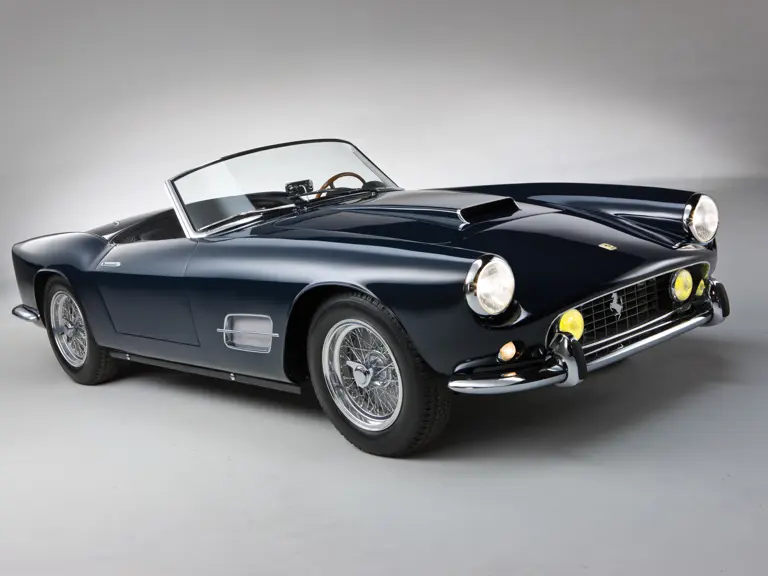
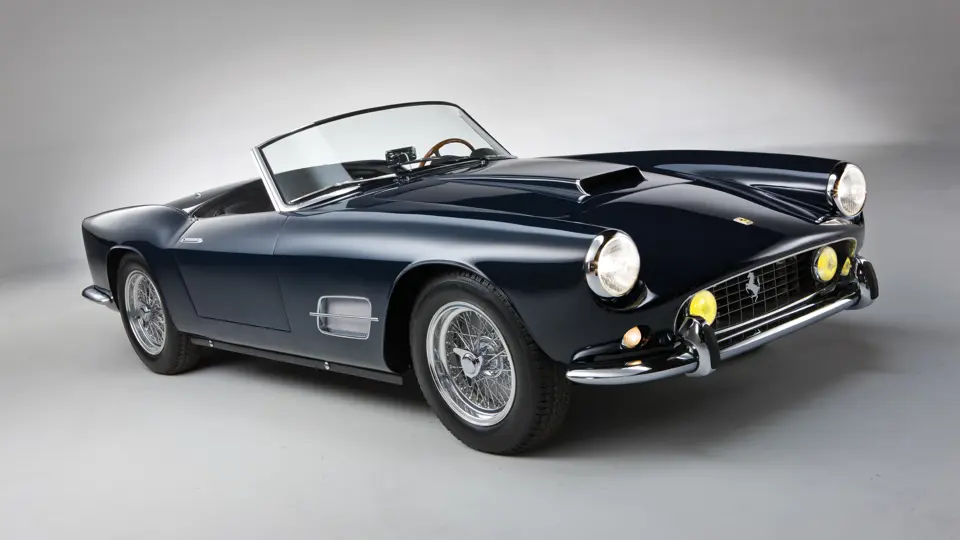
 | Cernobbio, Italy
| Cernobbio, Italy
